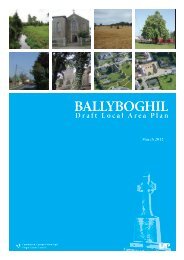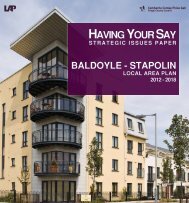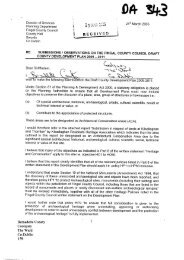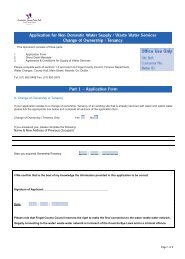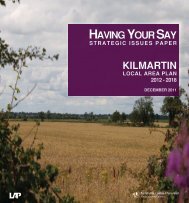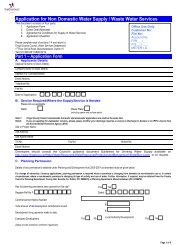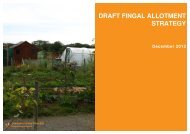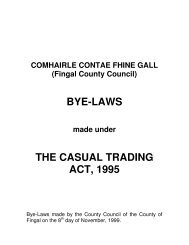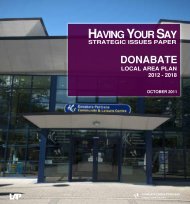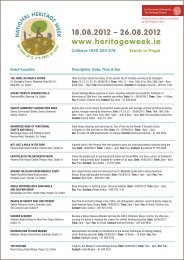Donabate Urban Centre Strategy Fingal County Council
Donabate Urban Centre Strategy Fingal County Council
Donabate Urban Centre Strategy Fingal County Council
Create successful ePaper yourself
Turn your PDF publications into a flip-book with our unique Google optimized e-Paper software.
8.0 Traffic Management Plan and Car Parking <strong>Strategy</strong><br />
An alternate policy may be to provide for a modest increase in car<br />
parking (possibly 10-20%) within a multi-storey facility and allow<br />
for commercial and residential development near the rail station.<br />
This would accord with good land-use and transportation planning<br />
and would contribute towards an active and lived-in town centre.<br />
Additional residential and commercial development would also<br />
require car parking within any facility however some degree of dualusage<br />
would be possible. A growth in public transport patronage<br />
should be sourced from walk-to, cycle-to and bus-to rather than<br />
drive-to demand. It will be important for the civic development of<br />
the town, as its population continues to grow in line with forecasts,<br />
to incorporate effective, sustainable and attractive traffic management<br />
measures.<br />
A very low level of on-street parking exists. Maintaining this low<br />
level would reinforce the development of a pedestrian-friendly and<br />
attractive town centre. A number of these could also be dedicated to<br />
mobility-impaired users to promote inclusion. Some perpendicular<br />
parking exists. It is recommended that this be replaced by parallel<br />
parking in order to provide a consistent parking system and maximise<br />
the space available to the public realm. No dedicated taxi parking<br />
exists. It is recommended that the optimum location for this would<br />
be adjacent to the rail station.<br />
Overall, the objective for <strong>Donabate</strong> town centre is to intensify the<br />
core areas through an increase in commercial and civic functions. In<br />
addition, it is an objective to foster a safe and attractive environment<br />
for all pedestrian and cycling users. This should be matched by a<br />
parking policy to placate or provide for existing development and<br />
to provide for additional development in line with <strong>Council</strong> parking<br />
standards.<br />
To achieve this, and to optimise use of scarce town centre lands,<br />
greater use of multi-storey and underground parking will be<br />
necessary. Such a policy may even create development opportunities;<br />
for example, at the existing shopping centre, surface car parking could<br />
be placed underground to facilitate increased levels of commercial<br />
and civic development.<br />
8.14 Conclusions<br />
The above outline discussions are based on local surveys, research<br />
of relevant studies and documentation and various workshops. The<br />
resulting recommendations are shown in the <strong>Donabate</strong> Transport<br />
<strong>Strategy</strong> Maps on pages 35 and 36 respectively.<br />
Given the transition to a town of up to 24,000 people, the creation<br />
of a strong “main street” with an investment in a definitive textured<br />
surface/high quality surface or cobble-effect or other quality surface<br />
is recommended for <strong>Donabate</strong>. Overall, as part of such town centre<br />
environmental improvements it is recommended to narrow the main<br />
street carriageway to a consistent and acceptable level for traffic in<br />
order to optimise facilities for pedestrians. A consideration for<br />
<strong>Donabate</strong> may be the provision of low gradient raised tables or an<br />
equivalent speed-reductive measure such as intermittent textured<br />
surface/high quality surface or cobble-effect at town centre approaches.<br />
In addition to proving a widened pedestrian crossing point at the town<br />
centre, an all-round crossing point is recommended at the northern<br />
end of the main street, while a third pedestrian crossing point could be<br />
integrated with an improved staggered bus stop layout at the southern<br />
end of the main street. However, the detailed design and location of all<br />
signals needs to be integrated and agreed with overall <strong>Council</strong> traffic<br />
management policy.<br />
It is recommended that a 30kmph zone be implemented from Hearse<br />
Road / Turvey Road (west of the rail crossing) to the junction of main<br />
street with the Portrane Road and continued past school entrances<br />
near the town.<br />
It is recommended that bus facilities be retained on the main street<br />
alignment in its current approximate location and be upgraded to a<br />
staggered layout incorporating a pedestrian crossing, strong pedestrian<br />
link to the rail station and bus boarder facilities. Provision will be made<br />
for bus turning and layby facilities in the development of Key Area 4 (as<br />
identified in <strong>Donabate</strong> LAP 2006)<br />
A number of priority cycle routes are recommended additional to<br />
those designated in the LAP. Other town centre cycle and pedestrian<br />
measures are recommended including a “cycle-station” facility at the<br />
train station, well-located cycle stands and a designated walking bus<br />
pick-up point.<br />
A managed car parking strategy is recommended at the rail station hub<br />
which would allow for a modest (up to 10%) increase in car parking<br />
within a multi-storey facility and also provide for commercial and<br />
residential development near the rail station.<br />
It is vital that the overall Transport and Access strategy for <strong>Donabate</strong><br />
Town <strong>Centre</strong> be delivered in tandem with and following the<br />
implementation of the Distributor Road. In fact, the initial Distributor<br />
Road traffic study included town centre traffic management measures,<br />
as set out in this study, as a vital part of its overall strategy.<br />
Overall, the objective for <strong>Donabate</strong> town centre is to intensify the core<br />
areas through an increase in commercial and civic functions. This can be<br />
achieved while improving local access and incorporating best practice<br />
principles, such as “Safer Routes to Schools” and the “Healthy Towns”<br />
initiatives. <strong>Donabate</strong> is an important commuter rail hub. However, any<br />
growth in public transport patronage should be sourced from walk-to<br />
cycle-to, and bus-to rather than drive-to demand. It will be important<br />
for the civic development of the town, as its population continues to<br />
grow in line with forecasts, to incorporate effective, sustainable and<br />
attractive traffic management measures.<br />
<strong>Donabate</strong> <strong>Urban</strong> <strong>Centre</strong> <strong>Strategy</strong> 33




